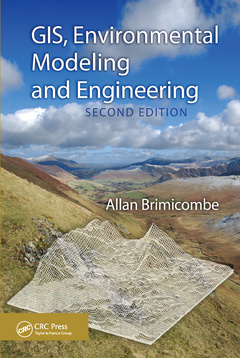Description
GIS, Environmental Modeling and Engineering (2nd Ed.)
Author: Brimicombe Allan
Language: English
Subjects for GIS, Environmental Modeling and Engineering:
Keywords
Environmental Simulation Modeling; SDSS; GIS Package; Spatial Data; Environmental Modeling; Data Sets; Distributed Parameter Models; Agent Based Modeling; Cellular Automata; IDW Interpolation; FDM; Hydrodynamic Modeling; Residual Errors; GIS Functionality; GIS Analyst; MC; Vendor GIS Package; Fuzzy Sets; Map Algebra; Linguistic Hedges; API; Decision Support System Environment; Common Language; Percentage Cover Species; Data Models
Publication date: 06-2020
· 15.6x23.4 cm · Paperback
Publication date: 01-2010
320 p. · 15.6x23.4 cm · Hardback
Description
/li>Contents
/li>Readership
/li>Biography
/li>
Spatial dimensions need to be properly captured if modeling and engineering techniques are to be successfully applied in addressing environmental problems. The links between the geographical information systems (GIS) that capture this data, simulation modeling, and engineering offer tremendous possibilities for building versatile support systems for managing the environment. GIS, Environmental Modeling and Engineering focuses on using GIS and external models to solve real environmental problems, promoting the critical thinking needed for the effective applications of these systems and their analytical outputs.
Divided into three major sections, this textbook first concentrates on defining GIS, identifying how data is structured, and explaining common functionality. The text examines GIS from a technological perspective, exploring the evolution of its scientific basis and its synergies with other technologies within a geocomputational paradigm. The next section explores modeling from a neutral scientific perspective in its role of simulating phenomena, as well as from a more specific perspective in its role within environmental science and engineering. The third and largest section looks at how GIS and simulation modeling are joined. It provides case studies and covers issues such as interoperability, data quality, model validity, space-time dynamics, and decision-support systems.
This volume provides seniors and postgraduate students with a structured, coherent text that goes beyond introductory subject matter by enabling readers to think critically about the data acquisition process and the results they get from the technology.
Professor Allan Brimicombe is Head of the Centre for Geo-Information Studies at the University of East London. Prior to this he was the founding Head of the Department of Land Surveying and Geo-Informatics at the Hong Kong Polytechnic University which in turn was preceded by a successful international career in consulting engineering.




